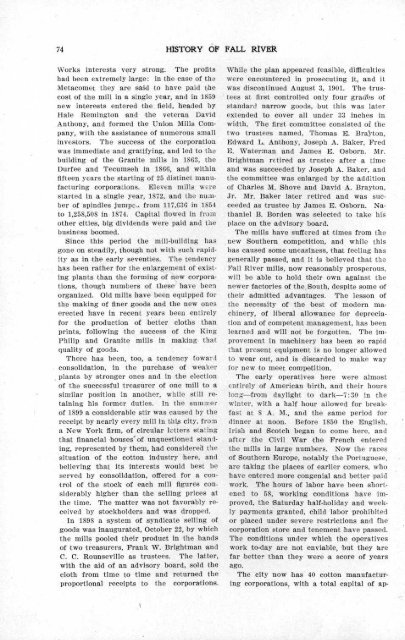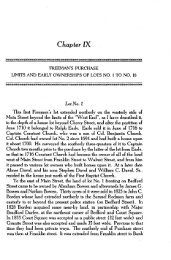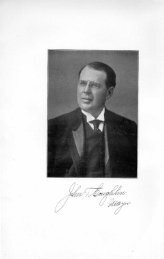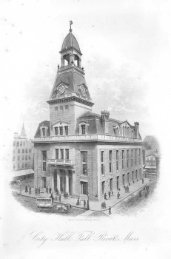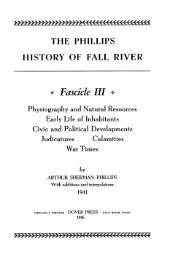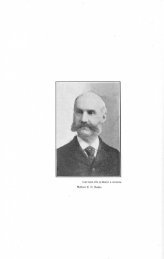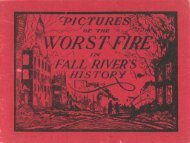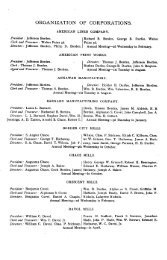Fall Rivers' Industries
Fall Rivers' Industries
Fall Rivers' Industries
Create successful ePaper yourself
Turn your PDF publications into a flip-book with our unique Google optimized e-Paper software.
74 HISTORY OF FALL RIVE R<br />
Works interests very strong. The profits<br />
had been extremely large : in the case of th e<br />
Metacomet they are said to have paid th e<br />
cost of the mill in a single year, and in 185 9<br />
new interests entered the field, headed b y<br />
Hale Remington and the veteran Davi d<br />
Anthony, and formed the Union Mills Company,<br />
with the assistance of numerous smal l<br />
investors. The success of the corporatio n<br />
was immediate and gratifying, and led to the<br />
building of the Granite mills in 1863, the<br />
Durfee and Tecumseh in 1866, and withi n<br />
fifteen years the starting of 25 distinct manufacturing<br />
corporations. Eleven mills were<br />
started in a single year, 1872, and the num -<br />
ber of spindles jumped from 117,636 in 18 54<br />
to 1,258,508 in 1874. Capital flowed in fro m<br />
other cities, big dividends were paid and th e<br />
business boomed .<br />
Since this period the mill-building ha s<br />
gone on steadily, though not with such rapidity<br />
as in the early seventies. The tendency<br />
has been rather for the enlargement of existing<br />
plants than the forming of new corporations,<br />
though numbers of these hav e been<br />
organized. Old mills have been equipped fo r<br />
the making of finer goods and the new one s<br />
erected have in recent years been entirely<br />
for the production of better cloths than<br />
prints, following the success of th e King<br />
Philip and Granite mills in making tha t<br />
quality of goods .<br />
There has been, too, a tendency towar d<br />
consolidation . in the purchase of weake r<br />
plants by stronger ones and in the electio n<br />
of the successful treasurer of one mill to a<br />
similar position in another, while still retaining<br />
his former duties. In the summe r<br />
of 1899 a considerable stir was caused by th e<br />
receipt by nearly every mill in this city, fro m<br />
a New York firm, of circular letters statin g<br />
that financial houses of unquestioned standing,<br />
represented by them, had considered th e<br />
situation of the cotton industry here, an d<br />
believing that its interests would best b e<br />
served by consolidation, offered for a control<br />
of the stock of each mill figures considerably<br />
higher than the selling prices a t<br />
the time. The matter was not favorably received<br />
by stockholders and was dropped .<br />
In 1898 a system of syndicate selling of<br />
goods was inaugurated, October 22, by whic h<br />
the mills pooled their product in the hand s<br />
of two treasurers, Frank W. Brightman an d<br />
C . C. Rounseville as trustees. The latter,<br />
with the aid of an advisory board, sold th e<br />
cloth from time to time and returned th e<br />
proportional receipts to the corporations .<br />
While the plan appeared feasible, difficultie s<br />
were encountered in prosecuting it, and i t<br />
was discontinued August 3, 1901 . The trustees<br />
at first controlled only four grades of<br />
standard narrow goods, but this wa s later<br />
extended to cover all under 33 inches i n<br />
width. The first committee consisted of th e<br />
two trustees named, Thomas E . Brayton ,<br />
Edward L. Anthony, Joseph A . Baker, Fre d<br />
E. Waterman and James E. Osborn. Mr .<br />
Brightman retired as trustee after a time<br />
and was succeeded by Joseph A . Baker, an d<br />
the committee was enlarged by the additio n<br />
of Charles M . Shove and David A . Brayton ,<br />
Jr. Mr. Baker later retired and was succeeded<br />
as trustee by James E . Osborn<br />
. Borden was selected to take . Na-thaniel B hi s<br />
place on the advisory board .<br />
The mills have suffered at times from th e<br />
new Southern competition, and while thi s<br />
has caused some uneasiness, that feeling has<br />
generally passed, and it is believed that th e<br />
<strong>Fall</strong> River mills, now reasonably prosperous .<br />
will be able to hold their own against th e<br />
newer factories of the South, despite some of<br />
their admitted advantages . The lesson of<br />
the necessity of the best of modern ma-<br />
chinery, of liberal allowance for depreciation<br />
and of competent management, has bee n<br />
learned and will not be forgotten . The improvement<br />
in machinery has been so rapi d<br />
that present equipment is no longer allowe d<br />
to wear out, and is discarded to make wa y<br />
for new to meet competition .<br />
The early operatives here were almos t<br />
entirely of American birth, and their hour s<br />
long—from daylight to dark—7 :30 in the<br />
winter, with a half hour allowed for breakfast<br />
at 8 A. M., and the same period fo r<br />
dinner at noon. Before 1850 the English ,<br />
Irish and Scotch began to come here, an d<br />
after the Civil War the French entere d<br />
the mills in large numbers . Now the race s<br />
of Southern Europe, notably the Portuguese ,<br />
are taking the places of earlier comers, wh o<br />
have entered more congenial and better pai d<br />
work. The hours of labor have been short-<br />
ened to 58, working conditions have im -<br />
proved, the Saturday half-holiday and weekly<br />
payments granted, child labor prohibite d<br />
or placed under severe restrictions an d the<br />
corporation store and tenement have passed .<br />
The conditions under which the operative s<br />
work to-day are not enviable, but they are<br />
far better than they were a score of year s<br />
ago .<br />
The city now has 40 cotton manufactur-<br />
ing corporations, with a total capital of ap-


